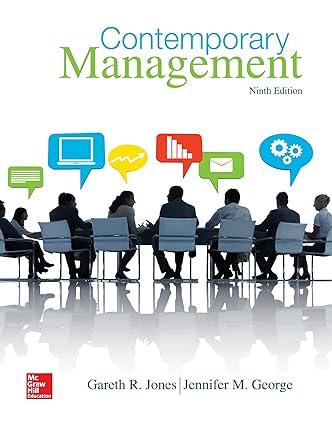Question
About three years ago, the East West Railroad (EWRR) and the Land Link Company (LLC) were corporate cousins, two of several subsidiaries of East West
About three years ago, the East West Railroad (EWRR) and the Land Link Company (LLC) were "corporate cousins," two of several subsidiaries of East West Land Link Company, Inc. At the time, EWRR and LLC both owned numerous properties all over the United States and Canada, as a result of prior acquisitions. A series of corporate restructurings then ensued, aimed at greater efficiency in the company's operations. Because LLC's expertise was in property management, approximately $500 million in property was transferred from EWRR to LLC, which included all of EWRR's property except areas that were directly under railroad tracks or that contained railroad yards. No money changed hands although "full and fair consideration of $1" was cited in the documents for the transaction. Other documents set forth the two companies' respective responsibilities for implementation of the transaction, including transfer of lease agreements, and so on, but they were silent on the issue of environmental liabilities. Within six months of the transfer of the properties, additional restructuring occurred, ultimately placing LLC and EWRR within two separate publicly traded corporate entities. (LLC became part of a new corporation.) The securities filings in connection with the issuance of stock for the new corporation Over the past two and a half years, however, estimates of the likely potential cost of environmental liability on the property transferred from EWRR to LLC under federal and state superfund statues have climbed to at least $500 millionthe property's entire value, or more. Inside and outside counsel for both companies have acknowledged that both would be PRPsPotentially Responsible Partiesunder the definitions in federal and state superfund statutes, which meant they would be technically liable for clean-up costs. However, federal and most state superfund statutes provide for an equitable allocation of cost among PRPs at a site. In other words, one PRP that has taken on the clean-up burden may sue other PRPs for a contribution. Subsequently, the court determines the equitable allocation of cost among the PRPs, according tocriteria established in relevant statutes and caselaw.
Because LLC owns other properties, in addition to those transferred from EWRR, it has a department charged with oversight of environmental assessment and clean-up (generally retaining independent contractors to perform the work). Because EWRR's railroad properties (particularly railroad yards, which were not part of the transfer) are often environmental nightmares, EWRR has staff experienced in environmental assessment and remediation work.
You are the CFO of LLC. Your general counsel has reviewed all of the relevant statutory and case law and has informed you of his strongly held opinion that, applying the criteria used by the courts, LLC could file suit against EWRR and would be "overwhelmingly successful in shifting up to 100% ofthecostburdentoEWRR."Hetoldyouthatheaskedoutsidecounseltoconsiderwhetheratype of "global" declaratory judgment suit or initiating a large number of suits regarding significant properties over many jurisdictions would be the best strategy. (In a declaratory judgment action, the court is asked to "declare" an answer to the legal question.) All counsel were uncertain about how a global declaratory judgment action would be structured or whether a single court would accept it as related to land outside its jurisdiction, particularly if not agreed to by the other side. Even if accepted by a court, such an action would be expensive (easily $750,000 to $1 million). Initiating suits in multiple jurisdictions would be even more expensive.
In order to avoid litigation, you approached the CFO of EWRR and suggested that the two companies retain an ADR firm, expert in tailoring ADR processes for unusual disputes and resolving them. He agreed. Over the last month or so, both sides have participated in a series of joint and private sessions, largely direct to the process question. Although you appeared briefly at the initial session, you have let your general counsel take the lead.
You met with your general counsel this morning for a progress report. He told you that the ADR consultants have found a real impasse in each side's assessment of the law, and how it would be applied to the facts. (While the parties' recitation of basic facts if similar, they differ in some significant respects and certainly in their interpretation of the facts.)
The bottom line is that your general counsel believes strongly that only a very small percentage of judges (fewer than 10%) would allocate more than an insignificant percentage (up to 15%) of the cost burden to LLC. EWRR and its general counsel take a nearly opposite view, believing that only a small percentage of judges (fewer than 15%) would allocate less than approximately half of the cost burden to LLC, and a significant percentage (30% to 40%) would allocate the majority of the burden to LLC. Although it appears that LLC and EWRR could agree on intelligent ways to divide the work on the properties, and to account for past remediation of work done, the issue of cost allocation remains a stumbling block.
As a next step, the ADR consultants have stated their intention to recommend a process to resolve what appears to be an impasse, but have explicitly asked for each side's input and suggestions on the issue.
What should you do? Should you call off the consultants? What type of process do you think would work best here? What are the risks?
Step by Step Solution
There are 3 Steps involved in it
Step: 1
Given the impasse in the ADR process regarding the allocation of cost burden between LLC and EWRR it is important to carefully consider the next steps ...
Get Instant Access to Expert-Tailored Solutions
See step-by-step solutions with expert insights and AI powered tools for academic success
Step: 2

Step: 3

Ace Your Homework with AI
Get the answers you need in no time with our AI-driven, step-by-step assistance
Get Started


